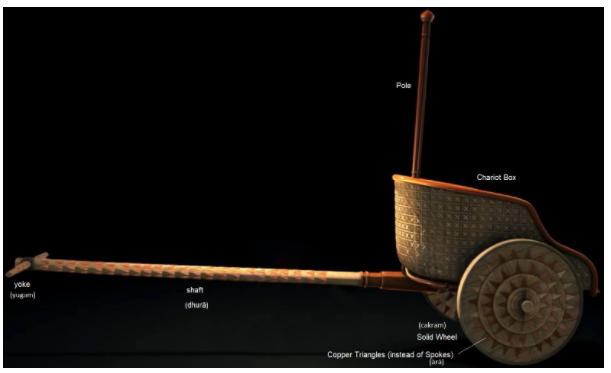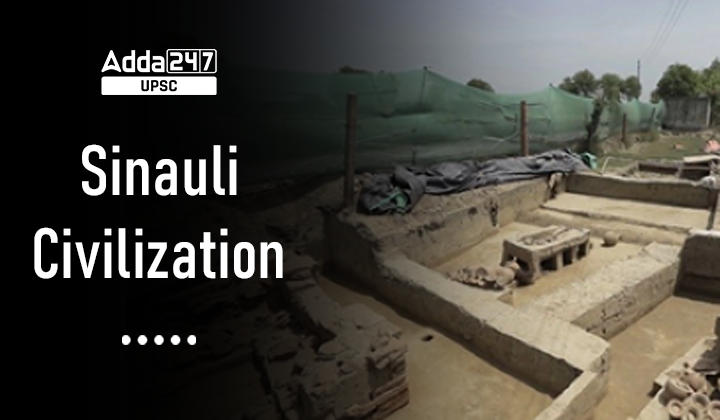Table of Contents
Relevance for UPSC
GS 1: Ancient Indian History
Sinauli Civilization: Introduction
- Archaeologists of the Archaeological Survey of India (ASI) under the leadership of Dr Sanjay Manjul excavated Sinauli in 2018. He discovered 116 burials there.
- Sanauli is a typical village situated in a fertile zone of fields abloom with wheat and millets and brick kilns all around, their tall stacks belching smoke.
- It is Asia’s largest burial site excavated as of now.
- The site gained attention for its Bronze Age solid-disk wheel carts, found in 2018, which were interpreted by some as horse-pulled “chariots”.
Sinauli Civilization: How old Sinauli civilization was?
- Most wooden artefacts which were found here were layered with copper sheaths, wires, and inlays, which helped them to remain intact for nearly 4000 years.
- The carbon dating tests have confirmed that this ancient burial site, where 126 burials were found, is around 4000 years old.
Sinauli Civilization: Sinauli Belonged to a warrior tribe
- The ASI has revealed that the elaborate burials, which included decorated legged coffins, underground chambers, and rice in pots buried with the bodies, likely belonged to an indigenous warrior tribe that inhabited the region.
- There are two C-14 (carbon dating) dates – 3815 and 3500, with a margin of error of 130 years for the Sinauli site, and added that the carbon dating marks this site as the earliest history of a warrior tribe in the Indian subcontinent.
Sinauli Civilization: The famous Chariot
- It provided the first ever ancient chariot discovered in Bharatavarṣa.
- This chariot is now dated to between 2100 BCE and 1900 BCE.
- It is a solid wheel chariot but contains triangular-shaped radial reinforcements made of copper (a different kind of spoke), making it better than the spoked wheel fast chariots unearthed in other parts of the world, avoiding quick breakage of wheels, while moving fast.
- The 3,000 BCE and 2,500 BCE solid wheel chariots unearthed from other cultures of the world like Mesopotamia pales in comparison with this advanced chariot unearthed from Sinauli.
- Placing this newly discovered Sinauli chariot in the same category as a solid wheel chariot in comparison to these 1,000 to 500 years older chariots, is an injustice to the Sinauli chariot.

Fig: The Sinauli Chariot (2100 BCE to 1900 BCE): Artist’s Reconstruction (Image courtesy: – The Secrets of Sinauli Documentary).
- The Sinauli Chariot has copper triangular reinforcements on the wheels, which can be vaguely called as spokes (ara), though not the kind of spokes understood in the spoked wheel chariots.
- These copper triangles give good integrity to the wheels and make it durable and are not meant for mere decoration.
Sinauli Civilization: A possible Rigvedic Connection
- The Ṛgvedic hymn 15 in the 10th Mandala speaks about both burying the dead (anagni-dagdha ) and cremating them (agni-dagdha).
- The hymn 18 of the 10th Mandala talks about a burial house (grha) often compared to a womb (yoni) where ghee (clarified butter) is kept in pots.
- This matches with the 116 burial houses unearthed at Sinauli.
- They contain many earthen pots which could have been used to fill offerings like ghee, butter and medicines.
- The Ṛgvedic hymn 18 of the 10th Maṇḍala mentions about taking the bow from the hand of the dead.
- The bow of the warrior taken from his hand is placed beside the dead-body of the warriors in Sinauli.
- Along with the bow, other weapons of the warrior like the shields and swords are kept.
- Their chariots, too, are kept in the burial house.
- A pair of chariots is seen in one of the Sinauli burial houses, possibly belonging to a king or a chief. This is close to the descriptions of the pair of Soma carts mentioned in the Rgveda (hymn 13 of the 10th Mandala).
Know about Harappan Civilization
|
Sinauli Civilization: Conclusion
In conclusion, the Sinauli chariots, the Sinauli burials and the Sinauli warriors of both genders are going to revise our understanding of our pre-History and we will be able to see a new narrative of Bharatavarsa emerging soon based on these remarkable findings.



 TSPSC Group 1 Question Paper 2024, Downl...
TSPSC Group 1 Question Paper 2024, Downl...
 TSPSC Group 1 Answer key 2024 Out, Downl...
TSPSC Group 1 Answer key 2024 Out, Downl...
 UPSC Prelims 2024 Question Paper, Downlo...
UPSC Prelims 2024 Question Paper, Downlo...
